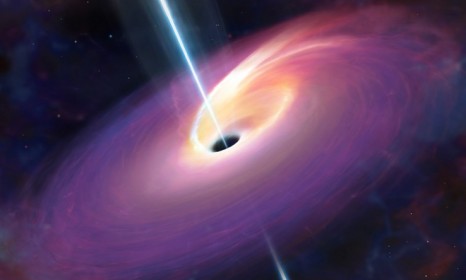The 'mayday call' from a murdered star
Astronomers believe they've uncovered the source of a mysterious blast of radiation that reached Earth in late March

Scientists believe they've solved one of the year's most puzzling mysteries of space. A highly unusual burst of gamma-ray radiation they detected earlier this year was, in fact, likely a "mayday call" of sorts from a star being ripped apart by a massive black hole. Here, a guide to the findings:
What was so unusual about this radiation burst?
In March, a NASA telescope detected a "bright flash" of gamma rays that was very different from typical bursts, which are the products of explosions in the cosmos, and "are extremely powerful, but very short," says Irene Klotz at Discovery News. But this burst was detected three more times over 48 hours — and gamma rays, x-rays, and infrared light can still be detected months after the initial alert. "This is truly different from any explosive event we have seen before," says Berkeley astronomer Joshua Bloom, as quoted by Reuters. It is "one of the brightest events ever recorded by astronomers," says Sophie Bushwick in Scientific American.
The Week
Escape your echo chamber. Get the facts behind the news, plus analysis from multiple perspectives.

Sign up for The Week's Free Newsletters
From our morning news briefing to a weekly Good News Newsletter, get the best of The Week delivered directly to your inbox.
From our morning news briefing to a weekly Good News Newsletter, get the best of The Week delivered directly to your inbox.
What caused the burst?
In a report in the journal Science, Bloom and his colleagues credit a star about the size of our sun being shredded by the gravitational effects of a massive black hole in a small galaxy in the Draco constellation, some 3.8 billion light-years away. The powerful burst has been prolonged "because as the black hole rips the star apart, the mass swirls around like water going down a drain, and this swirling process releases a lot of energy," says Bloom, as quoted by Space.com.
How rare is this?
Very. It "likely happens only once every 100 million years," says Denise Chow at Space.com. And it's unusual for this particular black hole to be feasting, too. "What's amazing is that we have here an otherwise quiescent, starving black hole that has decided to go on a sudden feeding frenzy for a short period of time," says Bloom, as quoted by National Geographic. Scientists say they are lucky to have a great view of the event. The spinning black hole belched out two jets of energy, with Earth smack in the path of one of those beams. That means the researchers are "looking down the barrel of that jet."
A free daily email with the biggest news stories of the day – and the best features from TheWeek.com
Sources: Discovery News, National Geographic, Reuters, Scientific American, Space.com
-
 Best poetry books of 2025
Best poetry books of 2025The Week Recommends Magnificent collections from Luke Kennard, Leo Boix and Isabelle Baafi
-
 ‘Furious Minds: The Making of the MAGA New Right’ by Laura K. Field and ‘The Dream Factory: London’s First Playhouse and the Making of William Shakespeare’ by Daniel Swift
‘Furious Minds: The Making of the MAGA New Right’ by Laura K. Field and ‘The Dream Factory: London’s First Playhouse and the Making of William Shakespeare’ by Daniel SwiftFeature An insider’s POV on the GOP and the untold story of Shakespeare’s first theater
-
 How to shop smarter with a grocery budget
How to shop smarter with a grocery budgetThe Explainer No more pushing your cart down the aisles on autopilot